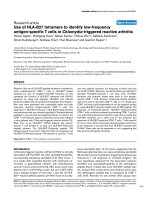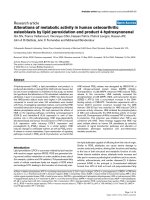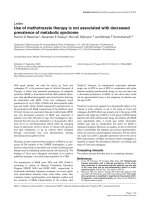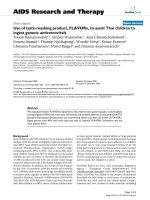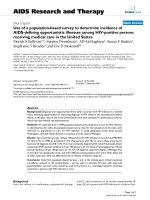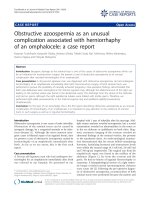Báo cáo y học: "Use of methotrexate therapy is not associated with decreased prevalence of metabolic syndrome – authors’ respons" pps
Bạn đang xem bản rút gọn của tài liệu. Xem và tải ngay bản đầy đủ của tài liệu tại đây (42.49 KB, 2 trang )
Available online />Page 1 of 2
(page number not for citation purposes)
We thank Raterman and colleagues for their interest in our
article ‘Methotrexate therapy associates with a reduced
prevalence of the metabolic syndrome in rheumatoid arthritis
patients over the age of 60: more than just an anti-inflam-
matory effect? A cross-sectional study’ [1]. Raterman and
colleagues replicated our analyses in their cohort of 353
rheumatoid arthritis (RA) patients from Holland but were
unable to demonstrate or confirm an association between
methotrexate (MTX) use and the metabolic syndrome (MetS)
defined by the National Cholesterol Education Program
(NCEP) 2004 and NCEP 2001 criteria. In an attempt to
address this discrepancy, they have raised several interesting
questions. The first is whether this association was present
only in RA patients treated with MTX monotherapy or also in
the subgroup treated with MTX as part of combination
therapy. The results presented in our original paper were
based on analysing all patients receiving MTX (n = 214),
irrespectively of whether this was monotherapy or combina-
tion therapy; however, adjustment was made in our multi-
variate model for other antirheumatic medications. In addition
to this, in the subgroup of patients taking MTX monotherapy
(n = 116) (Table 1), we have now replicated our original
findings, thus again supporting the possibility of a drug-
specific effect. Second, Raterman and colleagues request
further clarification of factors found to be independent
predictors of the MetS in our regression analyses. As stated
in this [1] and previous [2] papers on this cohort, factors
found to be independent predictors of the MetS in our
population were older age (β = 0.034, P <0.001), higher
health assessment questionnaire score (β = 0.335,
P = 0.024), and less MTX use β = 0.663, P = 0.001).
Diabetes and body mass index were also independent
predictors of the MetS but since they are included in the
MetS criteria, they were not included in the multivariate model
(for reasons of co-linearity). Although hypothyroidism is
clearly an important cardiometabolic risk factor, only 3/387 of
our patients were hypothyroid and this was not an
independent predictor of the MetS.
In summary, despite further investigation, we continue to
demonstrate a strong association between MTX and reduced
prevalence of the MetS. We remain unable to account for the
conflicting findings reported by Raterman and colleagues,
particularly as the descriptive characteristics of their
population are similar to ours. Clearly, both studies are limited
by their cross-sectional designs: the only way of establishing
the ‘true’ effect of MTX on the MetS would be in a large
prospective longitudinal study.
Letter
Use of methotrexate therapy is not associated with decreased
prevalence of metabolic syndrome – authors’ response
Tracey E Toms
1,2
, Vasileios F Panoulas
1
, Holly John
1
, Karen MJ Douglas
1
and George D Kitas
1,2
1
Department of Rheumatology, Dudley Group of Hospitals NHS Trust, Russells Hall Hospital, Pensnett Road, Dudley, West Midlands, DY1 2HQ, UK
2
ARC Epidemiology Unit, Manchester University, Oxford Road, Manchester, M13 9PT, UK
Corresponding author: George D Kitas,
Published: 21 September 2009 Arthritis Research & Therapy 2009, 11:414 (doi:10.1186/ar2806)
This article is online at />© 2009 BioMed Central Ltd
See related research by Toms et al., and related letter by Raterman et al.,
/>MetS = metabolic syndrome; MTX = methotrexate; NCEP = National Cholesterol Education Program; RA = rheumatoid arthritis.
Table 1
Odds ratios for having the metabolic syndrome in patients
receiving methotrexate monotherapy compared with those not
on methotrexate
NCEP 2004 NCEP 2001
OR (95% CI) OR (95% CI)
n = 62 n = 62
Crude 0.415 (0.21-0.82), 0.368 (0.19-0.73),
P = 0.011 P = 0.004
Model a 0.421 (0.21-0.84), 0.373 (0.19-0.75),
P = 0.014 P = 0.006
Model b 0.468 (0.23-0.99), 0.408 (0.19-0.84),
P = 0.038 P = 0.015
Crude: Unadjusted model. Model a: adjusted for age and gender.
Model b: adjusted for age, gender, disease duration, erythrocyte
sedimentation rate, and health assessment questionnaire score. CI,
confidence interval; NCEP, National Cholesterol Education Program;
OR, odds ratio.
Arthritis Research & Therapy Vol 11 No 5 Toms et al.
Page 2 of 2
(page number not for citation purposes)
Competing interests
The authors declare that they have no competing interests.
Acknowledgements
This work is supported by an Arthritis Research Campaign Clinical Fel-
lowship grant (grant number 18848 to TET) and an Arthritis Research
Campaign infrastructure support grant (grant number 17682, given to
the Dudley Group of Hospitals NHS Foundation Trust, Department of
Rheumatology). HJ is supported by an Arthritis Research Campaign
Educational Research Fellowship Grant (grant number 17883). VFP is
supported by a PhD scholarship from the Empirikion Institute, Athens,
Greece.
References
1. Toms TE, Panoulas VF, Douglas KMJ, Kitas GD: Methotrexate
therapy associates with a reduced prevalence of the meta-
bolic syndrome in rheumatoid arthritis patients over the age
of 60: more than just an anti-inflammatory effect? A cross-
sectional study. Arthritis Res Ther 2009, 11:R110.
2. Toms TE, Panoulas VF, Douglas KM, Griffiths HR, Kitas GD: Lack
of association between glucocorticoid use and presence of
the metabolic syndrome in patients with rheumatoid arthritis:
a cross-sectional study. Arthritis Res Ther 2008, 10:R145.

